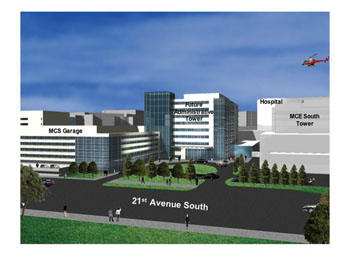
This artist’s rendering shows what the future entrance to VUH and TVC will look like.
Vanderbilt University Hospital’s future includes new tower, entrance
In February 2004, in his annual State of the Medical Center address, Vice Chancellor for Health Affairs Harry Jacobson, M.D., announced that Vanderbilt trustees had approved a plan for Vanderbilt University Hospital to be rebuilt and expanded in several phases, including the addition of a third bed tower above the Emergency Department.
While building a new hospital from scratch would cost $1 billion or more, expansion and rebuilding on the current site can be achieved for far less money.
With its larger patient care rooms and more unified floor plan, the recent fifth-floor rebuild introduced the redesign pattern to be followed as other areas of VUH are rebuilt.
The next phase of the project, to be completed by 2009, includes adding seven floors above the ED and using new unified floor plans to link this new tower and the two existing bed towers. This phase will add 126 intensive care beds and will significantly expand operating room capacity.
The third phase of the project includes adding floors 9 through 11 to the new tower above the ED, again using floor plans that link all three bed towers.
In phases four and five, the current towers will be expanded and squared off, so that, instead of three connected towers, the new hospital will rise as a single rectangular structure. Instead of the current 56 beds per floor, the expanded hospital will have up to 90 beds per floor. Average patient room size will almost double to 310 square feet. The size and number of waiting rooms will increase significantly, nurses stations will be larger and of a more open design and support areas and break rooms will be expanded.
Instead of the current open floor plans found in adult intensive care units, rebuilt ICUs will have individual patient rooms with glass doors, similar to intensive care rooms at the Monroe Carell Jr. Children's Hospital at Vanderbilt.
The Oxford House building will eventually be demolished, allowing creation of a main entrance to the hospital and The Vanderbilt Clinic in the form of a circular drive off 21st Avenue South. The entrance will be flanked by parking garages. A wide, glass-enclosed pedestrian bridge will cross 22nd Avenue to an expanded patient and visitor service area, including a larger Courtyard Café and new main elevator banks. The hospital lobby will move to the second floor, allowing Radiology and the ED to expand into the current lobby space. The new lobby will include a newsstand, expanded gift shop, coffee shop and a pharmacy.
The VUH rebuilding and expansion plan is part of the Vanderbilt University land use development plan. The plan for VUH is a collaboration among leaders of clinical departments, Space and Facilities Planning, Donald Blair & Partners Architects (New York), architects Earl Swensson Associates (Nashville), and Centex-Rogers Construction Inc. (Nashville).













